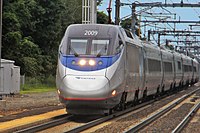
Photo from wikipedia
Innovation is intrinsically dependent on the construction of local infrastructure. Using panel data on 285 cities in China, we empirically examined the impact of high-speed rails on urban innovation and… Click to show full abstract
Innovation is intrinsically dependent on the construction of local infrastructure. Using panel data on 285 cities in China, we empirically examined the impact of high-speed rails on urban innovation and the mechanism underlying this effect. We found that high-speed rails significantly increase urban innovation. In our analysis, high-speed rails were found to increase the agglomeration of innovation factors, including population and investment, which in turn increase urban technological innovation. The agglomeration of investment factors brought about by high-speed rails is the main source of the improvement in urban innovation. Through the use of a spatial panel model, we found that high-speed rails promote knowledge dissemination and technology spillovers among the cities along high-speed railways, thus improving their innovation levels. However, the existing effects of high-speed rails on innovation exhibit spatial heterogeneity. We confirmed the effect of high-speed rails on innovation and explored the mechanism underlying this effect by considering the effects of factor agglomeration and knowledge spillovers. Our conclusions can be used as a resource by policymakers to stimulate knowledge and technology diffusion, which in turn cultivates and stimulates urban innovation.
Journal Title: PLoS ONE
Year Published: 2022
Link to full text (if available)
Share on Social Media: Sign Up to like & get
recommendations!